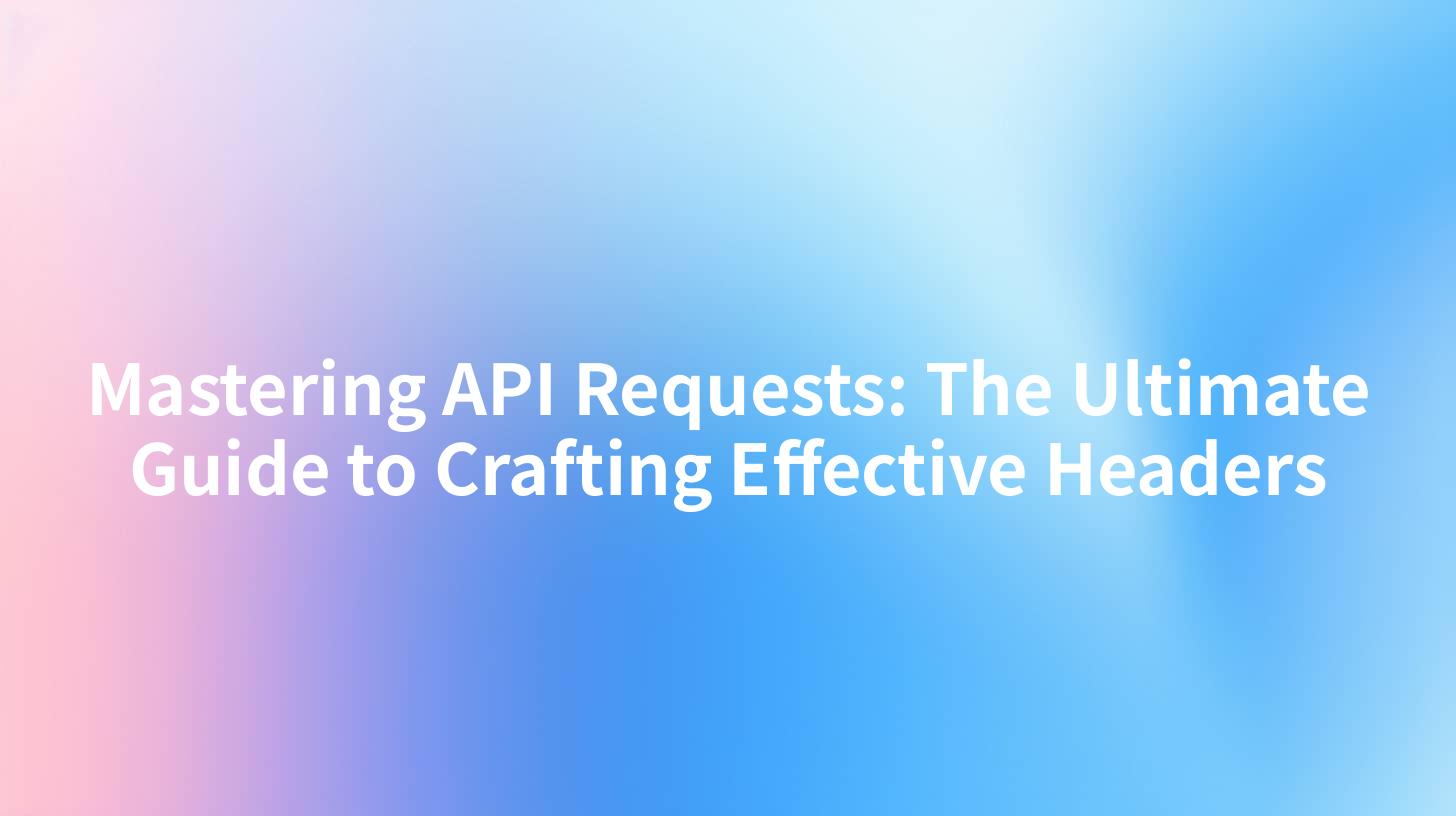Mastering API Requests: The Ultimate Guide to Crafting Effective Headers

Introduction
In the digital age, APIs (Application Programming Interfaces) have become the lifeblood of modern applications. They facilitate communication between different software systems, enabling seamless data exchange and integration. One of the critical components of API requests is the header, which plays a pivotal role in the success of your API interactions. This guide delves into the art of crafting effective API headers, ensuring that your requests are efficient, secure, and reliable.
Understanding API Headers
What are API Headers?
API headers are key-value pairs that are sent with an API request. They provide metadata about the request and are used by the server to process the request appropriately. Headers can contain information such as the request type, content type, authentication tokens, and other request-specific data.
Common API Headers
- Content-Type: Indicates the format of the data being sent in the request body.
- Authorization: Contains authentication credentials for the API, such as tokens or API keys.
- Accept: Specifies the format of the response that the client is expecting.
- User-Agent: Identifies the client application making the request.
Crafting Effective Headers
1. Choose the Right Headers
The first step in crafting effective headers is to choose the right ones for your API. Consider the following:
- Functionality: Select headers that are necessary for the API's functionality.
- Performance: Use headers that do not add unnecessary overhead.
- Security: Incorporate headers that enhance the security of your API.
2. Follow Best Practices
- Use Standard Headers: Stick to widely recognized headers for consistency.
- Be Descriptive: Choose header names that clearly describe their purpose.
- Avoid Custom Headers: If you must use custom headers, document them thoroughly.
3. Optimize Content-Type
The Content-Type header is crucial for API requests, especially when sending data in the body. Here are some guidelines:
- JSON: Use
application/jsonfor JSON data. - XML: Use
application/xmlortext/xmlfor XML data. - Form Data: Use
multipart/form-datafor file uploads.
4. Handle Authentication
Authentication headers are vital for securing your API. Here's how to handle them:
- OAuth: Use OAuth tokens for authentication.
- API Keys: Embed API keys in headers or query parameters.
- Basic Auth: Use basic authentication with caution and ensure it's properly encoded.
5. Consider Accept Header
The Accept header tells the server what format you expect in the response. It's essential for ensuring that the client can handle the response data:
- Specific Formats: Specify the exact format you want, like
application/jsonortext/html. - Accept Multiple Formats: If the client can handle multiple formats, use a wildcard like
*/*.
APIPark is a high-performance AI gateway that allows you to securely access the most comprehensive LLM APIs globally on the APIPark platform, including OpenAI, Anthropic, Mistral, Llama2, Google Gemini, and more.Try APIPark now! 👇👇👇
Case Study: APIPark
APIPark is an open-source AI gateway and API management platform that offers robust API header management. Here's how APIPark addresses some of the challenges mentioned earlier:
- API Gateway: APIPark serves as an API gateway, allowing you to define and manage headers for all your APIs.
- API Developer Portal: The API Developer Portal provides a user-friendly interface for managing headers and other API configurations.
- Security: APIPark offers features like API keys and OAuth tokens for secure authentication.
Best Practices for API Headers
Here's a table summarizing some of the best practices for API headers:
| Header Name | Description | Best Practice |
|---|---|---|
| Content-Type | Indicates the format of the request body. | Use standard formats like application/json or multipart/form-data. |
| Authorization | Contains authentication credentials. | Use secure methods like OAuth tokens or API keys. |
| Accept | Specifies the expected response format. | Use specific formats like application/json or a wildcard like */*. |
| User-Agent | Identifies the client application making the request. | Use a descriptive name that represents the client application. |
| X-Requested-With | Indicates the type of the HTTP request. | Use XMLHttpRequest for AJAX requests. |
| Connection | Indicates whether the client expects a persistent connection. | Use keep-alive for persistent connections. |
| Cache-Control | Controls the caching mechanism. | Use appropriate values like no-cache or max-age. |
| Date | Specifies the date and time of the request. | Always include this header to ensure proper caching and timestamping. |
Conclusion
Crafting effective API headers is an essential skill for any API developer. By following best practices and utilizing tools like APIPark, you can ensure that your API requests are efficient, secure, and reliable. Remember that the right headers can make all the difference in the success of your API integration.
FAQs
FAQ 1: Why are API headers important? API headers are important as they provide essential information about the request and are used by the server to process the request appropriately.
FAQ 2: How do I choose the right headers for my API? Choose headers that are necessary for the API's functionality, optimize for performance, and enhance security.
FAQ 3: Should I use custom headers in my API? Avoid custom headers unless necessary. If you do use them, document them thoroughly.
FAQ 4: What is the best practice for handling authentication in API headers? Use secure methods like OAuth tokens or API keys and ensure they are properly managed.
FAQ 5: Can API headers affect API performance? Yes, poorly chosen or implemented headers can add unnecessary overhead and impact API performance.
🚀You can securely and efficiently call the OpenAI API on APIPark in just two steps:
Step 1: Deploy the APIPark AI gateway in 5 minutes.
APIPark is developed based on Golang, offering strong product performance and low development and maintenance costs. You can deploy APIPark with a single command line.
curl -sSO https://download.apipark.com/install/quick-start.sh; bash quick-start.sh

In my experience, you can see the successful deployment interface within 5 to 10 minutes. Then, you can log in to APIPark using your account.

Step 2: Call the OpenAI API.


